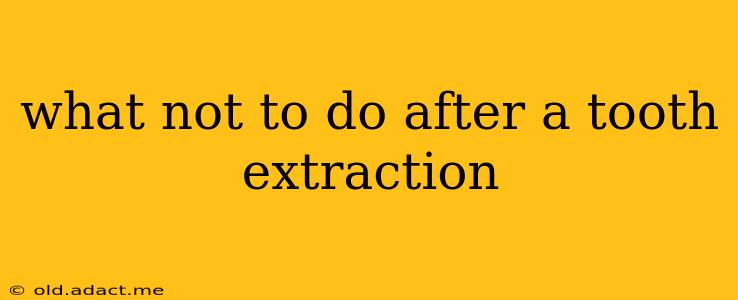Undergoing a tooth extraction can be a somewhat unsettling experience. While the procedure itself is usually straightforward, the post-extraction period is crucial for proper healing and preventing complications. Knowing what not to do is just as important as knowing what to do. This comprehensive guide will walk you through the critical dos and don'ts, helping you navigate your recovery smoothly.
What are the potential complications if you don't follow post-extraction instructions?
Failing to follow your dentist's post-extraction instructions can lead to several complications, including:
- Dry Socket: This painful condition occurs when the blood clot protecting the extraction site dislodges. It can significantly prolong healing and cause intense discomfort.
- Infection: Improper oral hygiene or introducing bacteria to the extraction site increases the risk of infection, potentially requiring antibiotics.
- Excessive Bleeding: Certain activities can disrupt the blood clot formation, leading to prolonged or excessive bleeding.
- Prolonged Healing: Neglecting post-operative care can significantly delay the healing process.
- Alveolar Osteitis (Dry Socket): As mentioned earlier, this is a painful complication where the blood clot is lost, exposing the bone.
What Not to Do Immediately After Tooth Extraction
The first few hours after your tooth extraction are critical. Avoid these actions:
- Spit forcefully: This can dislodge the blood clot, increasing the risk of a dry socket. Gently rinse your mouth as instructed by your dentist.
- Touch or probe the extraction site: Keep your fingers and tongue away from the wound to avoid infection and dislodging the blood clot.
- Smoke: Smoking significantly impairs healing and dramatically increases the risk of dry socket due to the reduced blood flow and introduction of irritants.
- Drink through a straw: The sucking action can dislodge the blood clot and lead to dry socket.
- Consume hot drinks or alcohol: These can interfere with healing and increase the risk of bleeding. Stick to cool, soft drinks.
- Vigorous rinsing or gargling: While gentle rinsing is usually recommended, forceful rinsing can disrupt the healing process.
- Exercise strenuously: Avoid strenuous physical activity immediately after the procedure as it can increase blood pressure and bleeding.
What Not to Do in the Days Following Tooth Extraction
The healing process continues for days and even weeks after your extraction. Here's what to avoid during this phase:
- Consume hard, crunchy, or sticky foods: These can irritate the extraction site and cause further damage or bleeding. Opt for soft foods like yogurt, mashed potatoes, and soup.
- Brush or floss aggressively near the extraction site: Be gentle around the area, avoiding direct contact with the wound for the first few days.
- Use mouthwash containing alcohol: Alcohol can irritate the sensitive area and hinder healing. Use a salt-water rinse as directed by your dentist.
- Neglect pain management: Follow your dentist's instructions for pain medication. Ignoring pain can lead to complications.
- Fail to schedule a follow-up appointment: Regular check-ups are crucial for monitoring healing and addressing any potential issues.
How long does it take to heal after a tooth extraction?
The healing time after a tooth extraction varies depending on factors such as the complexity of the procedure, individual healing capacity, and adherence to post-operative instructions. Most individuals experience substantial healing within a few weeks, but complete bone healing can take several months.
What are the signs of a dry socket?
A dry socket presents with intense, throbbing pain, often starting 2-3 days after the extraction. You may notice a foul odor and see an empty socket with exposed bone. If you experience these symptoms, contact your dentist immediately.
Can I eat after a tooth extraction?
Yes, but you should stick to soft foods for the first few days to avoid irritating the extraction site. Examples include applesauce, yogurt, mashed potatoes, and smoothies. Gradually reintroduce other foods as your comfort level increases.
When should I call my dentist after a tooth extraction?
Contact your dentist immediately if you experience:
- Severe pain: Pain that isn't controlled by prescribed medication.
- Excessive bleeding: Bleeding that doesn't stop after applying pressure.
- Signs of infection: Swelling, redness, pus, fever, or foul odor.
- Dry socket symptoms: Intense pain, exposed bone, and foul odor starting a few days after the extraction.
By carefully following your dentist’s instructions and avoiding these common mistakes, you can significantly improve your chances of a smooth and swift recovery after your tooth extraction. Remember, prevention is key to a successful healing process.
